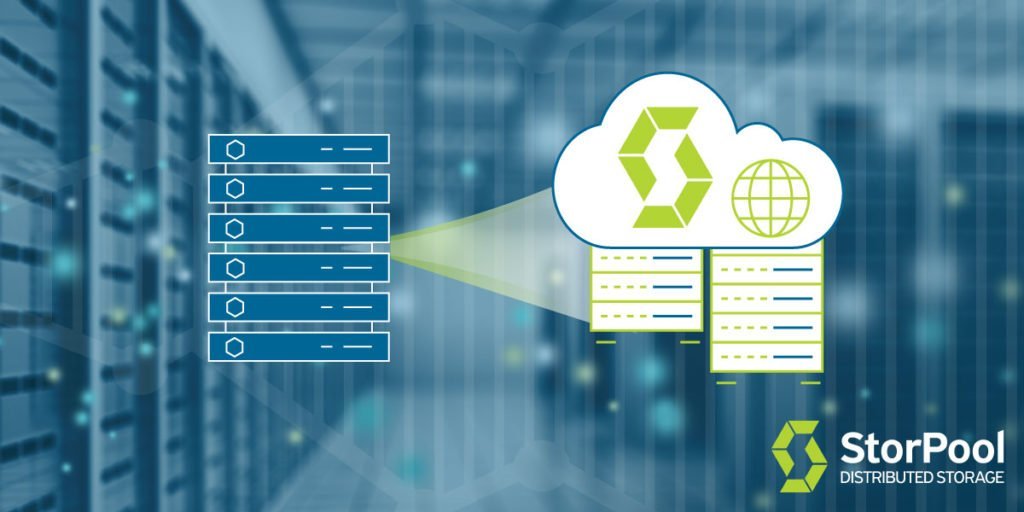For the last 2 years more and more companies are switching to Software Defined Storage (SDS). This process is driven by the fundamental changes in the IT market and business needs of the modern enterprise.
As IDC reports “For IT organizations undergoing digital transformation, SDS provides a good match for the capabilities needed – flexible IT agility; easier, more intuitive administration driven by the characteristics of autonomous storage management; and lower capital costs due to the use of commodity and off-the-shelf hardware,” said Eric Burgener, research director for storage, IDC. “As these features appear more on buyers’ lists of purchase criteria, enterprise storage revenue will continue to shift toward SDS.” [1]
The top 5 advantages, which SDS has over traditional SANs and all-flash SAN array (AFA)
The adoption of SDS is fundamentally driven by the many benefits it offers. Here we summarize the top 5 advantages, which SDS has over traditional SANs and all-flash arrays (AFA) and which advantages make SDS the prime choice of modern public and private clouds:
 Flexibility
Flexibility
One of the main advantages of a best-of-breed SDS solution is that it is versatile and can adapt to your needs, use case and circumstances.
For example: if you have 10 data centers around the world, each with its unique outlay, power density requirements, scale, type of customers – you name it – SDS can be easily tailored to fit in. In this way, companies can have a powerful and reliable IT infrastructure layer, yet will not have to apply a one-fits-all approach.
This will bring cost savings and simplify management, as regardless of where the datacenter is in the world – you can consolidate on one storage platform to power your entire business.
 Performance
Performance
Best-of-breed storage software solutions are as fast and in many cases faster than all-flash arrays. While the traditional all-flash SAN array is delivering hundreds of thousands of IOPS and sub-millisecond latency, this is nothing new or exciting for top-SDS solutions.
This is one of the main differences between the average software-defined distributed storage product and top-of-the-line distributed storage software. On paper (marketing claims) all SDS solutions deliver the same results and are thus interchangeable – speed, reliability, scalability.
However, performance and reliability tests have another story to tell – very few SDS solutions match or exceed the performance of good all-flash SAN array storage products like SolidFIre, Pure Storage, Nimble Storage or Tintri. Hower best of breed SDS can not only match but easily exceed in performance even the fastest flash arrays, on a dollar per dollar basis, for an equalizer.
 Scalability
Scalability
Because of the focus on hardware and its physical limitations, most flash arrays are limited by the underlying scalability of their architecture. SDS, on the other hand, was designed with PB+ scale in mind. Hardware is there to provide the platform to make it all happen, but data was at the center – not hardware and its limitations.
As a result, SDS solutions cover a very wide range of capacity – from 5 TB to 2 PB or more. This is a range, which would usually be covered by several product families of a traditional SAN or all-flash array vendors. With the best SDS solutions companies not only can start small, but they can grow as the need comes, without any interruptions, downtime or migrations of the workloads which run on the storage platform.
 Reduced vendor lock-in
Reduced vendor lock-in
The zero “vendor lock-in” concept is nice but close to impossible to achieve. In the end, customers always have soft or sometimes very hard lock-in to a given technology, IT stack or even staff competence.
However with SDS companies are much closer to “no vendor lock-in”. Customers can:
- Use all standard hardware, which is inexpensive and easy to procure.
- Change hardware platforms at wish, without complex and risky data migrations, as the data lives in the software layer, and is abstracted from hardware.
- Can change software storage vendors, as most provide a standard storage service and no “borders”.
 Cost Reduction
Cost Reduction
While important, this point comes last. By using SDS companies can save to a different extent, depending on their starting position and end goals.
For example, if a company refreshes an IT system, built entirely by a two- or three-letter vendors, with a new-age SDS-powered system – the cost savings will be significant. In other cases cost savings might be lower or on par with existing state. In this case the customer will get a much more capable and future-proof cloud, with all other advantages this brings.
The impact of the switch from an all-flash SAN array to Software-Defined Storage
It is important to note that the very best software-defined storage solutions are not “cheap”. However they will still deliver very good TCO (Total Cost of Ownership). This is so because leading SDS products optimize costs across the stack – compute, network and storage. Sometimes, more importantly, they will reduce the cost for staff, by managing the storage service on behalf of the customer. This has a very positive impact on the bottom line of SDS-powered projects as staff costs are the main expense for most IT companies. Now companies can choose to optimize staff. Or they can focus freed-up man-power to more profitable core business activities and thus grom revenue and market share.
—
[1] News covered by StorageNewsletter.com: https://www.storagenewsletter.com/2017/10/05/software-defined-storage-solutions-to-generate-worldwide-revenue-of-16-2-billion-in-2021-idc/
Get more information
Want to know more for how to switch from an all-flash SAN array to Software-Defined Storage and all the benefits? Do not hesitate to contact StorPool for more information or advice.
Fill in the form bellow and we will contact you.
